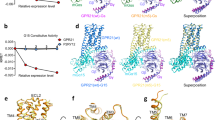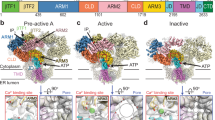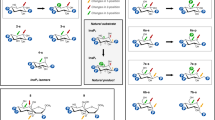Abstract
We report the crystal structures of the ligand-binding domain (LBD) of a rat inositol 1,4,5-trisphosphate receptor (InsP3R) in its apo and InsP3-bound conformations. Comparison of these two conformations reveals that LBD's first β-trefoil fold (β-TF1) and armadillo repeat fold (ARF) move together as a unit relative to its second β-trefoil fold (β-TF2). Whereas apo LBD may spontaneously transition between gating conformations, InsP3 binding shifts this equilibrium toward the active state.
This is a preview of subscription content, access via your institution
Access options
Subscribe to this journal
Receive 12 print issues and online access
$189.00 per year
only $15.75 per issue
Buy this article
- Purchase on Springer Link
- Instant access to full article PDF
Prices may be subject to local taxes which are calculated during checkout



Similar content being viewed by others
References
Berridge, M.J., Lipp, P. & Bootman, M.D. Nat. Rev. Mol. Cell Biol. 1, 11–21 (2000).
Taylor, C.W., da Fonseca, P.C. & Morris, E.P. Trends Biochem. Sci. 29, 210–219 (2004).
Clapham, D.E. Cell 131, 1047–1058 (2007).
Foskett, J.K., White, C., Cheung, K.H. & Mak, D.O. Physiol. Rev. 87, 593–658 (2007).
Mignery, G.A. & Sudhof, T.C. EMBO J. 9, 3893–3898 (1990).
Miyawaki, A. et al. Proc. Natl. Acad. Sci. USA 88, 4911–4915 (1991).
Newton, C.L., Mignery, G.A. & Sudhof, T.C. J. Biol. Chem. 269, 28613–28619 (1994).
Yoshikawa, F. et al. Biochem. Biophys. Res. Commun. 257, 792–797 (1999).
Rossi, A.M. et al. Nat. Chem. Biol. 5, 631–639 (2009).
Bosanac, I. et al. Nature 420, 696–700 (2002).
Bosanac, I. et al. Mol. Cell 17, 193–203 (2005).
Yoshikawa, F. et al. J. Biol. Chem. 271, 18277–18284 (1996).
Uchida, K., Miyauchi, H., Furuichi, T., Michikawa, T. & Mikoshiba, K. J. Biol. Chem. 278, 16551–16560 (2003).
Chan, J. et al. J. Mol. Biol. 373, 1269–1280 (2007).
Jiang, Q.X., Thrower, E.C., Chester, D.W., Ehrlich, B.E. & Sigworth, F.J. EMBO J. 21, 3575–3581 (2002).
Hamada, K., Terauchi, A. & Mikoshiba, K. J. Biol. Chem. 278, 52881–52889 (2003).
Serysheva, I.I. et al. J. Biol. Chem. 278, 21319–21322 (2003).
Wolfram, F., Morris, E. & Taylor, C.W. Biochem. J. 428, 483–489 (2010).
Tung, C.C., Lobo, P.A., Kimlicka, L. & Van Petegem, F. Nature 468, 585–588 (2010).
Joseph, S.K., Brownell, S. & Khan, M.T. Cell Calcium 38, 539–546 (2005).
Acknowledgements
We thank T.C. Südhof (Stanford University) for sharing the InsP3R1-cDNA, J.K. Foskett (University of Pennsylvania) for providing the InsP3R1-cDNA–containing plasmid and for discussion, K. Schmitz (University of Pennsylvania) for assistance in crystal diffraction, G. Van Duyne (University of Pennsylvania) for both the modified pET21 plasmid containing a TEV site and the TEV-cDNA–containing plasmid, staffs of the synchrotron beam lines at the Advanced Photon Source (GM/CA-CAT 23-ID-B and 23-ID-D) and the Advanced Light Source (8.2.1 and 8.2.2) for technical assistance, Y. Xu (University of Pennsylvania) for technical assistance, and P. De Weer (University of Pennsylvania) for critical review and discussion of our manuscript. This study was supported by the Howard Hughes Medical Institute.
Author information
Authors and Affiliations
Contributions
C.-C.L., K.B. and Z.L. conducted the experiments, analyzed the data and prepared the manuscript.
Corresponding author
Ethics declarations
Competing interests
The authors declare no competing financial interests.
Supplementary information
Supplementary Text and Figures
Supplementary Figures 1–6, Supplementary Table 1 and Supplementary Methods (PDF 14689 kb)
Supplementary Movie 1
LBD structures with and without InsP3 bound, viewed alternatingly as in Fig. 1a,b, then as in Fig. 1c,d, followed by a zoom-in view of the InsP3-binding region with InsP3-interacting side chains. β-TF2 was used as reference to align the bound and unbound structures. (MOV 2442 kb)
Rights and permissions
About this article
Cite this article
Lin, CC., Baek, K. & Lu, Z. Apo and InsP3-bound crystal structures of the ligand-binding domain of an InsP3 receptor. Nat Struct Mol Biol 18, 1172–1174 (2011). https://doi.org/10.1038/nsmb.2112
Received:
Accepted:
Published:
Issue Date:
DOI: https://doi.org/10.1038/nsmb.2112
This article is cited by
-
Structural titration reveals Ca2+-dependent conformational landscape of the IP3 receptor
Nature Communications (2023)
-
Exploration of inositol 1,4,5-trisphosphate (IP3) regulated dynamics of N-terminal domain of IP3 receptor reveals early phase molecular events during receptor activation
Scientific Reports (2019)
-
Bcl-2 and IP3 compete for the ligand-binding domain of IP3Rs modulating Ca2+ signaling output
Cellular and Molecular Life Sciences (2019)
-
Cryo-EM reveals ligand induced allostery underlying InsP3R channel gating
Cell Research (2018)
-
PTEN counteracts FBXL2 to promote IP3R3- and Ca2+-mediated apoptosis limiting tumour growth
Nature (2017)



